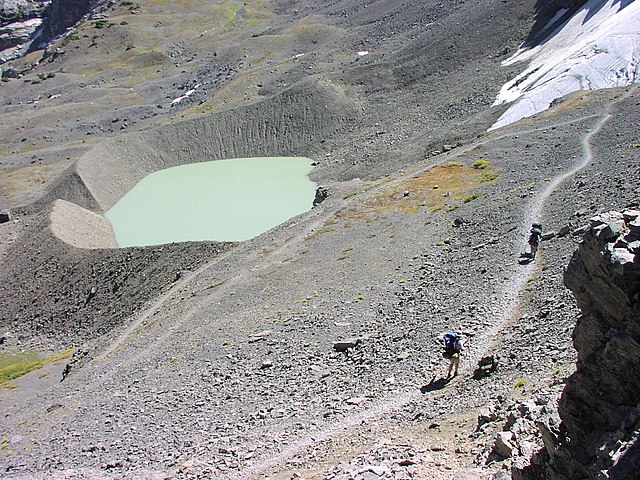Top Qs
Timeline
Chat
Perspective
Proglacial lake
Lake formed by the action of ice From Wikipedia, the free encyclopedia
Remove ads
In geology, a proglacial lake is a lake formed either by the damming action of a moraine during the retreat of a melting glacier, a glacial ice dam, or by meltwater trapped against an ice sheet due to isostatic depression of the crust around the ice.[1] At the end of the last ice age about 10,000 years ago, large proglacial lakes were a widespread feature in the northern hemisphere.


Remove ads
Moraine-dammed


The receding glaciers of the tropical Andes have formed a number of proglacial lakes, especially in the Cordillera Blanca of Peru, where 70% of all tropical glaciers are. Several such lakes have formed rapidly during the 20th century. These lakes may burst, creating a hazard for zones below. Many natural dams (usually moraines) containing the lake water have been reinforced with safety dams. Some 34 such dams have been built in the Cordillera Blanca to contain proglacial lakes.
Several proglacial lakes have also formed in recent decades at the end of glaciers on the eastern side of New Zealand's Southern Alps. The most accessible, Lake Tasman, hosts boat trips for tourists.
On a smaller scale, a mountain glacier may excavate a depression forming a cirque, which may contain a mountain lake, called a tarn, upon the melting of the glacial ice.[2]
Remove ads
Ice-dammed
Summarize
Perspective

The movement of a glacier may flow down a valley to a confluence where the other branch carries an unfrozen river. The glacier blocks the river, which backs up into a proglacial lake, which eventually overflows or undermines the ice dam, suddenly releasing the impounded water in a glacial lake outburst flood also known by its Icelandic name a jökulhlaup. Some of the largest glacial floods in North American history were from Lake Agassiz.[3] In modern times, the Hubbard Glacier regularly blocks the mouth of Russell Fjord at 60° north on the coast of Alaska.[4]
A similar event takes place after irregular periods in the Perito Moreno Glacier, located in Patagonia. Roughly every four years the glacier forms an ice dam against the rocky coast, causing the waters of the Lago Argentino to rise. When the water pressure is too high, then the giant bridge collapses in what has become a major tourist attraction. This sequence occurred last on 4 March 2012, the previous having taken place four years before, in July 2008.[5]
About 13,000 years ago in North America, the Cordilleran Ice Sheet crept southward into the Idaho Panhandle, forming a large ice dam that blocked the mouth of the Clark Fork River, creating a massive lake 2,000 feet (600 m) deep and containing more than 500 cubic miles (2,000 km3) of water. Finally this Glacial Lake Missoula burst through the ice dam and exploded downstream, flowing at a rate 10 times the combined flow of all the rivers of the world. Because such ice dams can re-form, these Missoula Floods happened at least 59 times, carving Dry Falls below Grand Coulee.
In some cases, such lakes gradually evaporated during the warming period after the Quaternary ice age. In other cases, such as Glacial Lake Missoula and Glacial Lake Wisconsin in the United States, the sudden rupturing of the supporting dam caused glacial lake outburst floods, the rapid and catastrophic release of dammed water resulting in the formation of gorges and other structures downstream from the former lake. Good examples of these structures can be found in the Channeled Scablands of eastern Washington, an area heavily eroded by the Missoula Floods.[6]
The following table is a partial list of rivers that had glacial ice dams.
Remove ads
Retreating ice sheet

The retreating glaciers of the last ice age, both depressed the terrain with their mass and provided a source of meltwater that was confined against the ice mass. Lake Algonquin is an example of a proglacial lake that existed in east-central North America at the time of the last ice age. Parts of the former lake are now Lake Huron, Georgian Bay, Lake Superior, Lake Michigan and inland portions of northern Michigan.[1] Examples in Great Britain include Lake Lapworth, Lake Harrison and Lake Pickering. Ironbridge Gorge in Shropshire and Hubbard's Hills in Lincolnshire are examples of a glacial overspill channel created when the water of a proglacial lake rose high enough to breach the lowest point in the containing watershed.
See also
- Ice jam – Accumulation of ice in a river
- List of prehistoric lakes
- Proglacial lakes of Minnesota – Group of lakes in Minnesota, United States
- Pluvial lake – Landlocked basin (endorheic basin)
- Subglacial lake – Lake under a glacier
- Supraglacial lake – Pond of liquid water on the top of a glacier
- Lacustrine plain
References
Bibliography
Wikiwand - on
Seamless Wikipedia browsing. On steroids.
Remove ads
